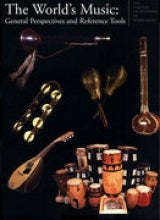Information Resources for Ethnomusicology

The end of the quarter... the time when the Archive typically gets the most questions and the most users. Since many of the Ethnomusicology students seem to be working on papers and assignments, I thought I would highlight some of the most-used resources in Ethnomusicology.
Do you have a listening assignment? Check out the Archive's catalog to find out what we have, then come to the Archive and listen to the recordings. Prefer to listen from home? I would recommend two resources.
Smithsonian Global Sound®, which makes accessible tens of thousands of audio recordings and hundreds of videorecordings, including the published recordings owned by Smithsonian Folkways and the archival audio collections of Folkways Records, Cook, Dyer-Bennet, Fast Folk, Monitor, Paredon, and other labels, as well as recordings from the Ralph Rinzler Folklife Archives and Collections and content from partner archives including the International Library of African Music, the Archives and Research Centre for Ethnomusicology of the American Institute for Indian Studies, and the Aga Khan Music Initiative for Central Asia of the Aga Khan Trust for Culture.
Contemporary World Music, which is a complementary database to Smithsonian Global Sound. Contemporary World Music includes a blend of contemporary and traditional world music recordings, including: reggae, worldbeat, neo-traditional, world fusion, Balkanic jazz, African film, Bollywood, Arab swing and jazz, Indian classical, fado, flamenco, klezmer, zydeco, gospel, gagaku, and more. Recording labels included are: Topic, Playasound, Buda Musique, Air Mail Music, Manuiti, Lyrichord World Music, Navras Records, and INEDIT.
For a full list of audiovisual resources available, go to my Ethnomusicology Research Guide Audiovisual Online page. The first page includes resources that cover most or much of the world. If you are looking for recordings from a specific geographic region, please use the pull-down menu on the "Audiovisual Online" tab above and choose the appropriate geographic area: Africa, the Americas, Asia, Australia and the Pacific, Europe, the Middle East.
If you are writing a paper, here are some of the basic resources.
The Garland Encyclopedia of World Music is a great place to begin. It is the first comprehensive online resource devoted to music research of all the world's peoples. It includes more than 9,000 pages of material, combined with entries by more than 700 expert contributors from all over the world. Its founding editors were two UCLA Ethnomusicology professors, Timothy Rice and James Porter.
If you are searching for articles about a particular subject, you need to look at a periodical database. Ethnomusicologists might need to review a variety of resources, but these are the basics for music studies.
RILM: Abstracts of Musical Literature, which provides broad international coverage of Western and Eastern classical music, pop, folk, and jazz, as well as interdisciplinary studies on music. It includes citations in over 202 languages from 3,700 journals. Abstracts and citations are drawn from articles, books, conference proceedings, bibliographies, catalogs, dissertations, festchriften, iconographies, critical commentaries to complete works, ethnographic recordings, videos, and reviews. Coverage is 1969 to date.
Music Index is a comprehensive guide to music periodicals and literature featuring digitized content from 1970 to present. It contains cover-to-cover indexing and abstracts of articles for more than 475 periodicals, as well as book reviews, obituaries, news, and selective coverage for more than 230 periodicals. NOTE that RILM and Music Index are both hosted by Ebsco, so you can search these databases at the same time.
MPA: Music & Performing Arts Online indexes music periodicals from 1874 to the present and includes more than 770,000 citations and abstracts from over 445 music journals published in 25 countries and in 17 languages. Coverage includes classical music and ethnomusicology to hip-hop and popular music.
Those studying the music industry or popular music, should check out Entertainment Industry Magazine Archive. EIMA is an historical archive of major trade and consumer magazines, from their inception to 2000. Includes Variety, Billboard, Picturegoer, Screen International, and more. Subject coverage includes: Film industry, Music business, Rock and pop, Jazz and blues, Theater, Television, Radio.
To learn about more about to find articles, dissertations, newspapers, and reference resources, go to this section of my Ethnomusicology Research Guide.
And if you need any help evaluating and citing resources, look at this section of the Guide.
Looking for books about your topic? Search the UCLA Library catalog, then go to the appropriate campus library. Most of you will probably find what you're looking for in the Music Library.
As always, remember, there are countless resources available. If you need more information or assistance, ASK A LIBRARIAN!





